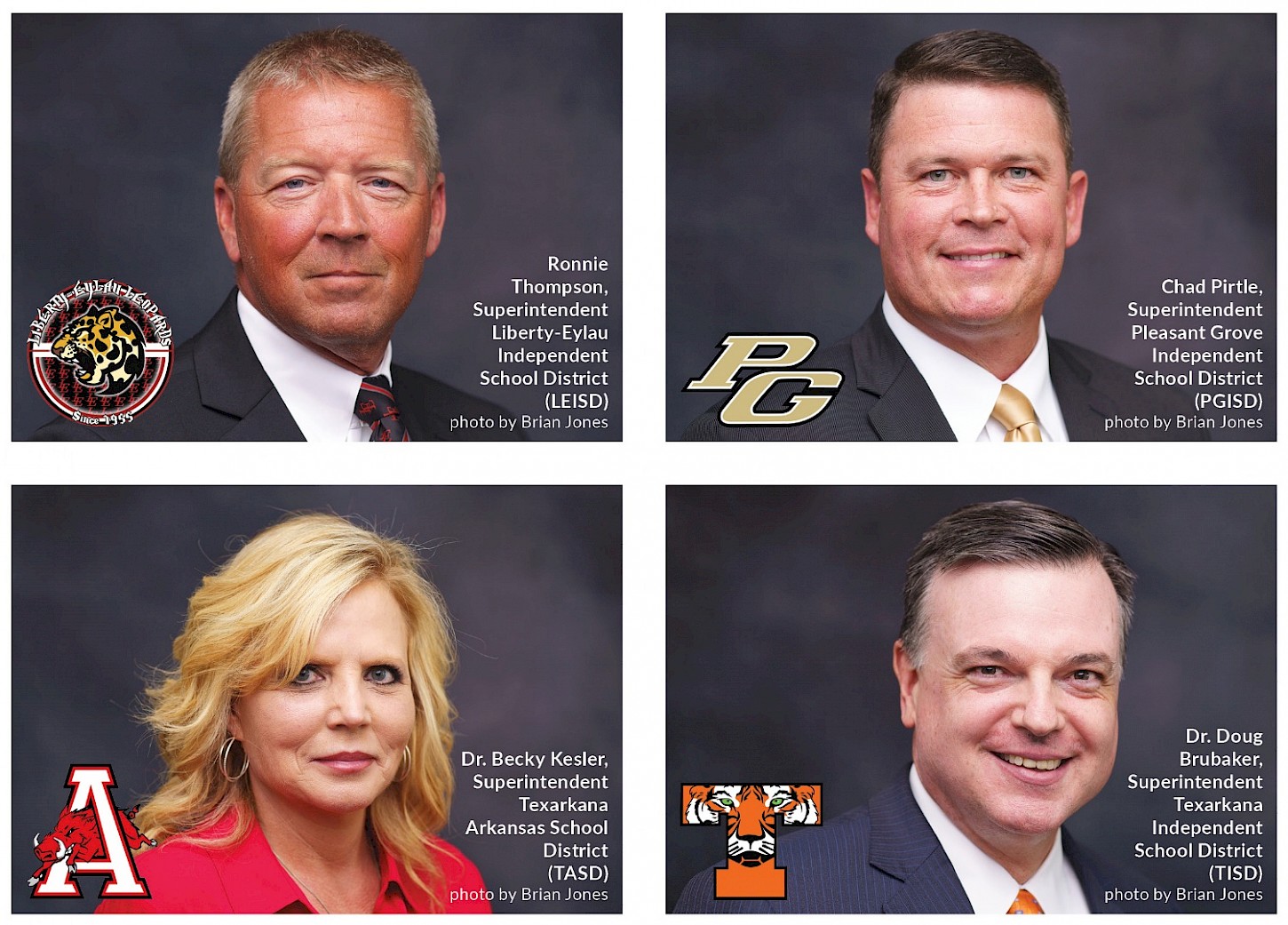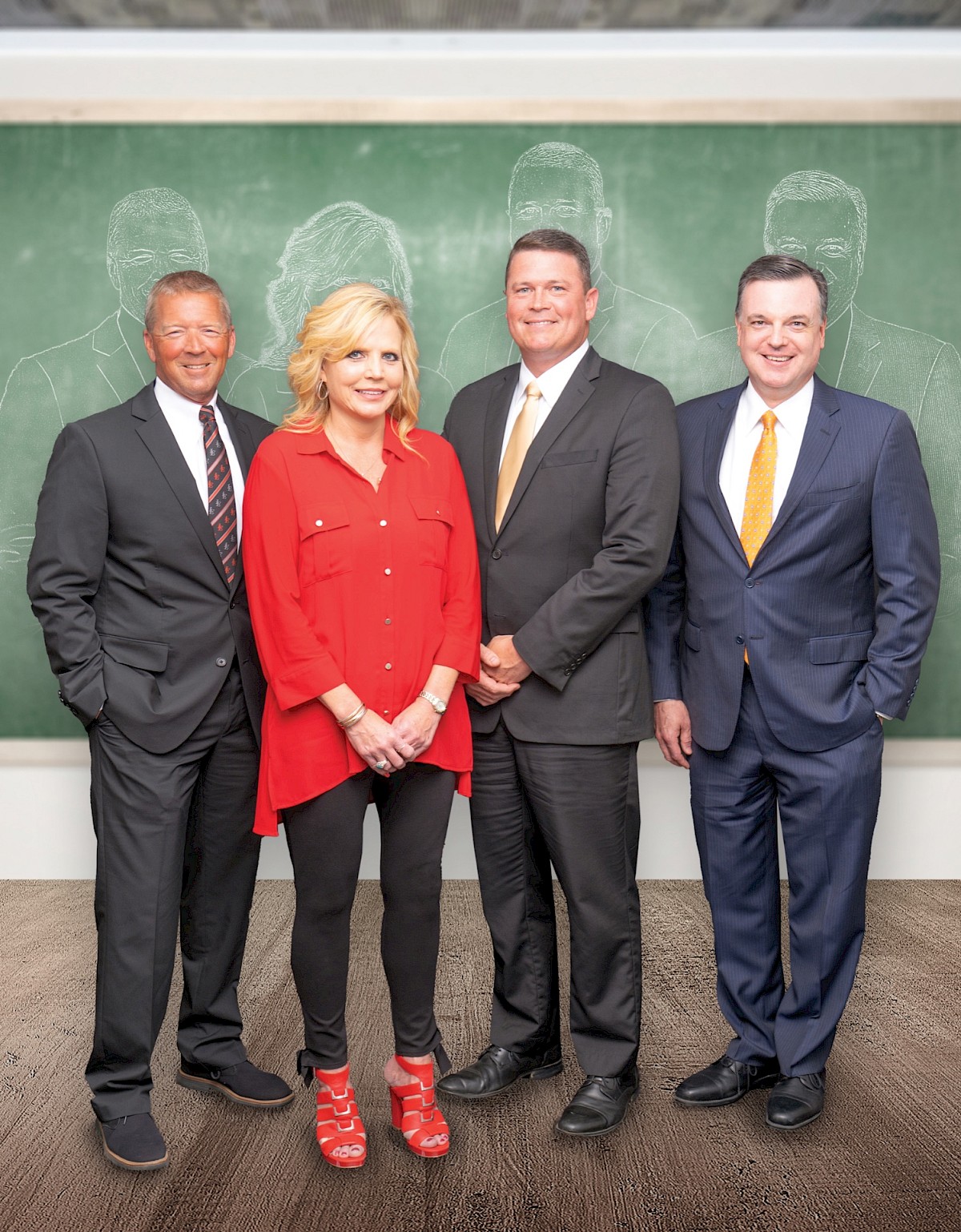4 Leaders, 2 Cities, 1 Purpose
With the days of summer drawing to a close, there is an all-too familiar anticipation growing. The start of school triggers different emotions for everyone, but hopes are high for the upcoming academic year.
Coming out of the COVID-19 pandemic, we have all said we are ready to “get back to normal.” But what is “normal?” What will the 2021-2022 school experience be like for our students and teachers?
These Texarkana Superintendents explained their views of the educational excellence in our community and shared their hopes for the days ahead: Dr. Becky Kesler of Texarkana Arkansas School District (TASD), Dr. Doug Brubaker of Texarkana Independent School District (TISD), Ronnie Thompson of Liberty-Eylau Independent School District (LEISD), and Chad Pirtle of Pleasant Grove Independent School District (PGISD).
Our local administrators were unified not only in their admittance of the challenges of the previous school year, but also of the strength and growth their campuses experienced along the way. “COVID affected everything,” said Chad Pirtle (PGISD), “but nothing was necessarily detrimental because of the aid provided by the state and the federal government which allowed us to purchase a large amount of technology.” Pleasant Grove used allotted funds to make upgrades in technology, adding enough devices for every student in grades three through twelve. Campuses received state and federal funds to aid during the pandemic, but it was up to each district to serve the specific needs of their unique populations.
Connectivity for at-home learning was an obstacle for many public schools. “The challenge for us was not so much the devices you put in kids’ hands, but the infrastructure in the background that makes it work,” said Ronnie Thompson (LEISD). “Our district is half city, half rural, and a lot of our rural kids did not have quality connectivity at home. When your internet speed is buffering because that’s the best you can get, there are certain things you can’t participate in. For kids going through virtual education at the time, they suffered because of connectivity.”
Despite their differing school colors, the superintendents voiced a common admiration for the resiliency of their students and staff and expressed how each district’s caring campus culture was demonstrated during the pandemic. Through that experience, their true colors were revealed.
“We pride ourselves in the family atmosphere we have at TASD,” said Dr. Becky Kesler. “One of the things I was so proud of our staff this last year was that they really took ownership with our students. So many of our students chose to stay virtual instead of coming back to school, so our teachers would actually make home visits. If we felt like we were losing a student, the teacher would go to the student’s home. They would take food to the student, take a computer to them, or hot spots. They really embraced that family mentality, and I was so proud of the fact that we really tried to not let anyone fall through the cracks.”
Dr. Doug Brubaker moved to TISD in January 2021. “When I was interviewing with the board, and then after I got here, it wasn’t long before people started talking about the ‘Tiger Family.’ It’s this beautiful spirit that permeates the staff and student body, where people just really take care of one another. Joining the district when I have, I had the opportunity to really see that in full effect with the pandemic being such a challenging time.”
“In Pleasant Grove Independent School District, we talk about a ‘state of mind,’” explained Pirtle (PGISD). “We highlight ‘state’ because in everything we do, we are striving to be the best in the state. I’m passionate about taking care of our people. I also think the positivity and joy that radiates through our campuses is unique.”
“One of the big things we did during the pandemic was we made sure our kids got fed,” said Thompson (LEISD). “That was important because for a lot of them, their meals for the day happened when they came to school. When COVID shut schools down, our Food Services Department was still working pretty much full time. We would use our bus routes and deliver breakfast and lunch meals. There were also some federal funds that flowed through the State that allowed us to buy technology and Personal Protection Equipment and gear that we needed. We also actually got with our Career and Technology Department, and they built us hand sanitizing stations. They’re building 30 more this summer, so we’ll have even more on our campuses this school year. That was important because they were on back order for months. Our welding teacher said he thought he could make it. He made one, and the rest is history.”

As we settle into a “new normal” this fall, educators have a monumental task on their hands. With such a challenging year in the rear-view mirror, the consensus among the group was to focus on a positive school experience and celebrate progress in their districts.
“I think assessing and addressing the individual needs of students as we kick off the school year is going to be one of the most important challenges we face,” said Brubaker (TISD). “In terms of setting a positive tone, I think about what has been accomplished over the last 18 months. TISD staff members and their peers across the state have kept schools functioning for kids. That’s an amazing accomplishment. I’m also really excited about a strategic planning initiative we have set up this fall. We’re going to be engaging the community in dialogue about what we want our schools to look like five years from now.”
Thompson (LEISD) further explained that public schools have to accept that “the biggest challenge is closing the educational gaps that were developed during the pandemic. Even for kids who chose face-to-face learning the entire school year, they still had to be quarantined and were virtual at some point. I think parents and the community realized there’s a difference between virtual and face-to-face learning. When you’re at home, there are going to be gaps. To overcome those gaps, it’s going to take a good three to five years, unfortunately. But that’s the reality and the greatest challenge facing us as educators moving forward.”
“I’m excited for our students and staff to have the opportunity to have a much more normal year than what we just experienced in 2020-2021,” added Pirtle (PGISD). “I’m excited on the academic side about the literacy initiative we have in our school district. My goal is by 2025 to have 100% of our kids reading on grade level.
Kesler (TASD) shared recent changes to their district structure: “We just completed our new middle school north of the interstate, Arkansas Middle School. Our sixth grade will join them this year. That left College Hill Middle School empty, so we made that campus College Hill Harmony—our leadership and music school. Every student will get an instrument to play, and we expect about 400 students to be there. Our junior high, that was known as North Heights, is going to be known as The Heights next year. It will be a MicroSociety school. They’ll have their own mayor, city council and a whole society within the school. It’s a really neat concept, and the parents are excited about it and the accelerated curriculum we will offer there. Every student at The Heights will work a grade level ahead. Our Gifted and Talented program will also be there, and we’ll have about 200 students on that campus next year.”
With the rapid growth of technology and the continual expansion of curriculum and activities on our campuses, there is no telling what the school experience will be like for future generations. “When I go out to our schools, I see our kids coding; I see them working in robotics; I see them in art; I see the things they’re doing in music; there are times when I’d like to check myself back in and start over,” said Brubaker (TISD). “If you look at 20 years from now, I think we’re going to see technology giving us the opportunity to tailor experiences to individual needs and interests, and I’m really excited to see how that’s going to unfold.”
However, there are core elements to the future academic experience some hope will never change. “There’s nothing that takes the place of a face-to-face teacher,” said Kesler (TASD). “The students would probably say they want to go virtual and do only online learning in the future. But I’m hoping in 20 years we still have classrooms and teachers. There’s always a place for online learning, but I’m old school, and I hope we still have face-to-face learning going on. That relationship is so critical, and nothing will take the place of the relationship between a teacher and a student.”
Mr. Pirtle (PGISD) expounded on that idea and reflected on the influence his third-grade teacher, Mrs. Whitney, made on his life. “I don’t really remember what she taught me, but I remember that she loved me. We probably all have someone who had that kind of impact on us. I would like to say to the Texarkana Community: Find a way to love our teachers. They do so much for our kids, so my challenge to you is to love our teachers.”
The strength of education in our area and the talented leadership guiding our campuses into the new school year sets the tone for not only a more “back-to-normal” experience for our students, but an extraordinary one.


